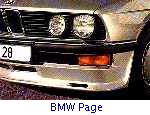



![[parking.jpg - 29.34 K]](http://www.garageboy.com/multimedia/parking.jpg)
The Art of Owning a BMW within the confines of New York City is a feat unto itself. However, it is a particularly exact science to find safe and legal parking around the city when you choose your BMW over public transportation. This is true whether you live in Manhattan or are a "bridge-and-tunnel-type" like me - sometimes, you simply prefer to use your car.
Your average rocket scientist can drive into any parking garage and hand the keys to an attendant. This only requires the ability to spend money faster than God intended. The likelihood of returning to your car in the condition you left it is pretty high - unless, of course, it's a special BMW, in which case the likelihood of hearing the squeal of your tires as you walk out of the garage is also pretty high! It also doesn't take much of an intellect to park close to a fire hydrant, a bus stop, or under a No Parking sign. That doesn't require brains - it only requires cajones. And luck - luck that you probably don't deserve.
Therefore, based on my experiences, I have listed some simple rules to
follow which I hope can help you on your quest for a favorable parking
place:
Rule #1:
Before you even think
of parking, you must determine the
risk involved with your
car. Simply, the type of BMW you drive
determines the risk you run. Your one-of-a-kind never-been-hit 2002tii
belongs in a parking garage most of the time (actually it doesn't
belong on the streets of New York City at all), right alongside your
brand-new 540i 6-speed (you know, the one with 2000 miles on it). Car
thieves who hunt for new cars usually drive flat-bed trucks. No legal
car alarm will protect your investment from a determined professional.
But once your car is 3 or more years old, the risk of theft diminishes,
while the risk of vandalism remains. Nonetheless, I believe there is
an abundance of safe parking on the island of Manhattan, if you know
how to look for it.
Rule #2:
Make sure your car has an effective car alarm. Spare all the
flashing technicolor lights and screaming sirens, unless you want your
neighbors to hate you. If the car is compromised, the ignition must be
disabled, so the car cannot be moved easily or quickly. This is the
only important item in an alarm. Everything else is secondary. Most
newer BMWs have this ability built into the factory alarms, and the
Coded-Driveaway Protection of the most recent models decreases your
risk dramatically. If the car is broken into, at least it will still
be where you parked it.
Rule #3: Do not leave
anything in the car. Leaving items in your car
within plain sight will only invite trouble. Remove the Valentine
and
the EZ-Pass. If you need to remove large items from the car, place
these in the trunk long before you reach your destination. Placing
items in the trunk once you've parked is also an invitation for a
break-in - you look like a tourist.
Rule #4:
Don't use The Club. It insults the intelligence of the
average car thief, since he's had the master key for The Club since
1985. And if he doesn't have it handy (might have traded his last one
for a vile of crack), he'll use a WhipIt he stole from the local head
shop to freeze it off in 10 seconds. The *only* use for The Club is in
hand-to-hand cabbie combat. I know. I've seen it and it's not pretty.
If you want to make your car more secure, simply turn the steering
wheel to full lock before you turn off the engine, and make sure the
steering wheel locking mechanism is engaged after the key is removed.
Rule #5:
When looking for parking places, watch pedestrians to see if
they're walking towards a vehicle. Studies show that people who walk
towards a car have a distinctive walk. Some people even walk with keys
in their hand - this is a dead ringer.
Rule #6:
As you drive (particularly on cross streets, not avenues),
focus one of your three eyes around the cars in front of you - this
will help you to look far down a side of a street at potential
openings.
Rule #7:
If there is precisely enough room to fit one BMW plus 4
inches, there is enough room to park. Your BMW has a great turning
radius - the car practically slides in sideways. Try it.
Rule #8:
When following Rule #7, rely heavily on Parking By Braille,
particularly if you have an older BMW with non-painted bumpers. This is
a practice to help you determine how much room you have between you
and
the car you're parking in front of. It's very simple - when you hit
the car, you have zero inches left. This is also very effective to
determine how much room you have between you and the car you're parking
behind. The same procedure applies.
Rule #9:
Know your limitations. You will *not* find street parking a
block from the Empire State Building in the middle of a weekday
afternoon. Don't look for parking near Madison Square Garden just
prior to a Knicks game. Following, listen to the traffic reports on
the radio for information about street closures and important events.
On the AM dial (unless you have an Internet radio in your car), there's
880 on "the eights" (:08, :18, :28, etc.) and 1010 on "the ones" (:01,
:11, :21, etc).
Rule #10:
Read the parking signs. Follow the rules (look out for
Sunday-also meters). And FIGHT all unjust parking tickets. I have
successfully fought EVERY unjust ticket, by mail, in all my years of
parking in New York City. If you are reasonable and clear and correct,
you will win... every time.
Rule #11:
Practice, practice, practice. There is no substitute for
experience - for example, there is excellent parking just one block
west of Greenwich Village in the evenings, but you'd never know it if
you were stuck in traffic on Sixth Avenue in the middle of the Village.
It takes time to discover prime parking venues - and experience teaches
you the difference between luck and careful planning.
Rule #12:
Every time you park, wish your car a fond farewell. Thank
it for being a faithful companion and say goodbye. It's always
possible that you will never see it again. Then, when you return to
discover your car waiting for you, you will greet it with a smile and
appreciate it that much more.
The remaining rules are difficult to quantify, since they involve
specific issues of how
to look, where
to look, and when
to look for
parking. This is why finding safe and legal parking in New York City
remains an art form. But fear not. This will be explained as part of a
comprehensive education in how to drive in New York City.


